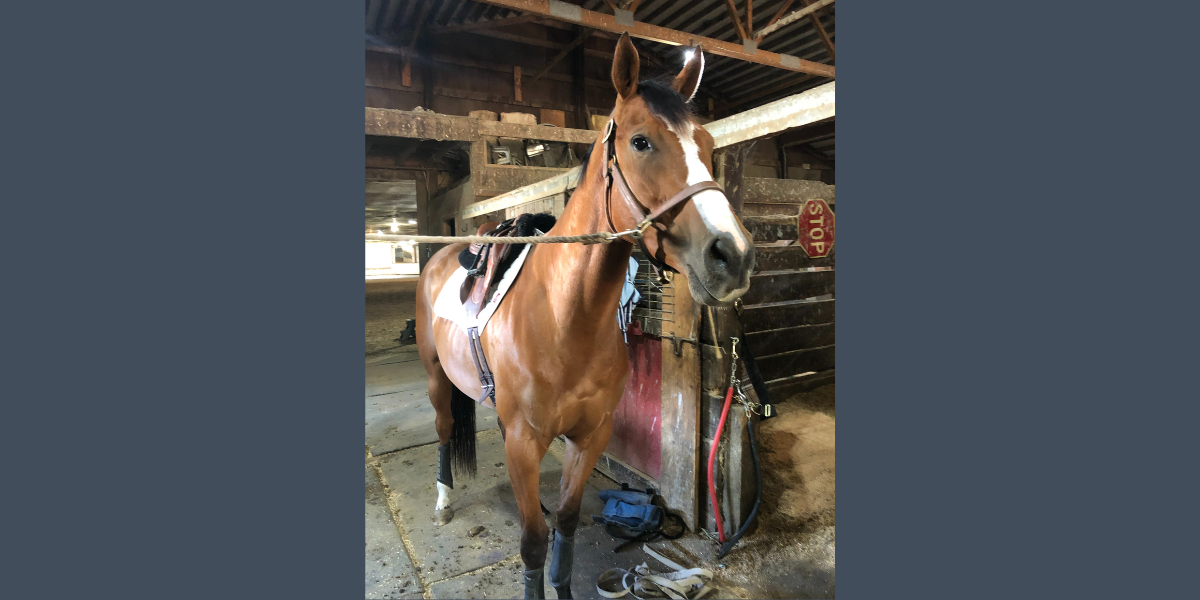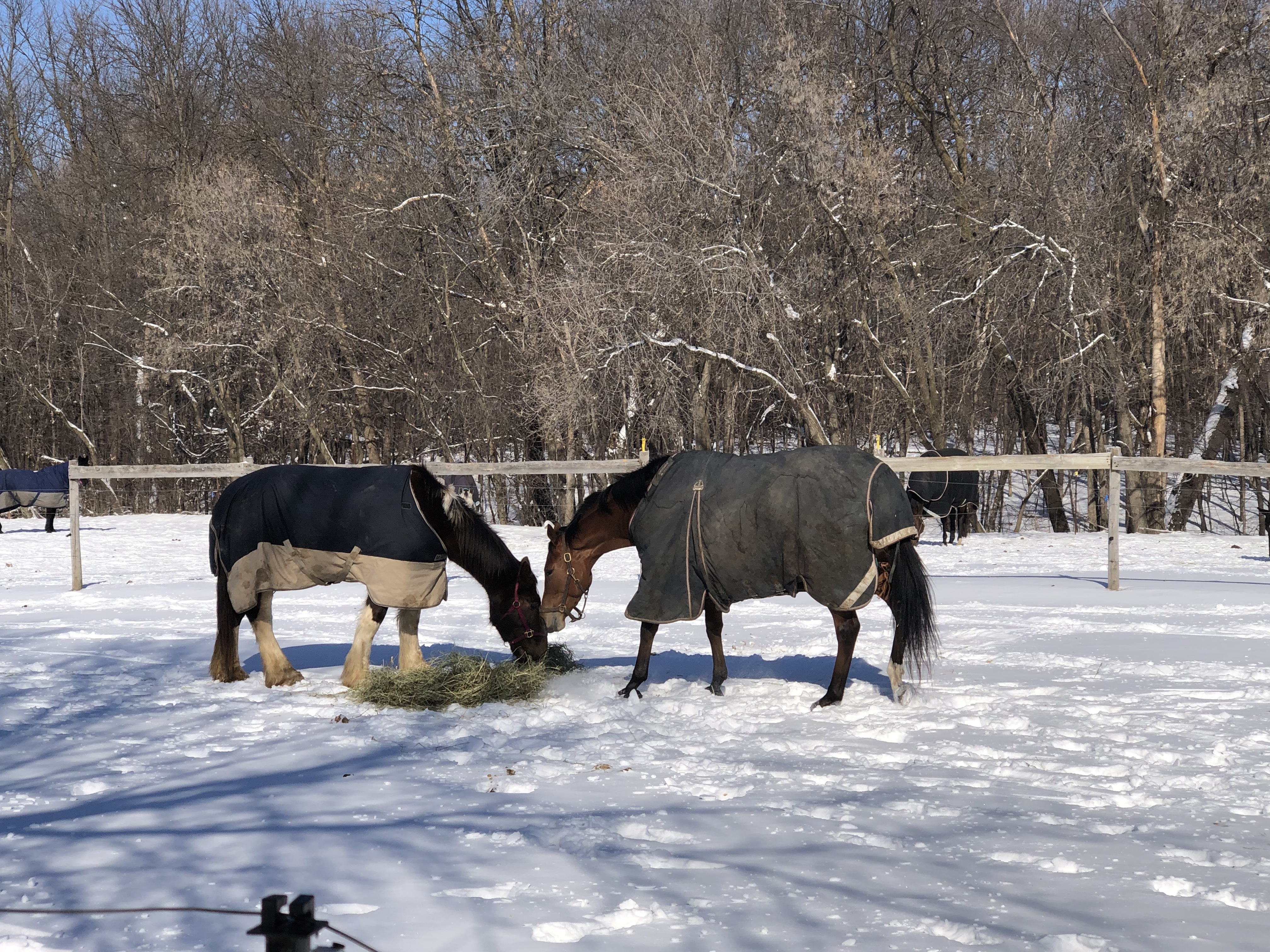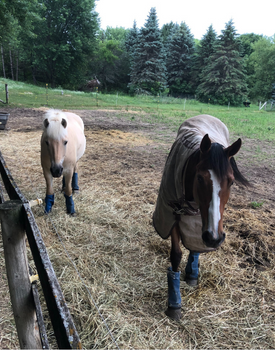Equine emergency
Young mare receives urgent care after incident leaves three legs injured, one limb cut to the bone

Young mare receives urgent care after incident leaves three legs injured, one limb cut to the bone
Bunny, a 3-year-old thoroughbred, stands in the barn ready to get to work. Photo courtesy of Kati Bodin.
No one can ever be sure of exactly what happened, but Kati Bodin will never forget the aftermath.
On a cool morning in October 2022, she arrived at one of her horse paddocks to see a group of mares standing in a circle and members of her barn staff nearby. They were gathered around Bunny, a 3-year-old thoroughbred Bodin had purchased earlier that year. Deep, bloody cuts marred three of the horse’s limbs.
The best Bodin can guess is Bunny and another mare got into an altercation and the young horse did her best to escape the situation, jumping over the fence but colliding with a post on her descent. The post’s broken remains supported the theory.
“There's a five-foot fence around that paddock and she cleared most of it, but then she hit the post on the way down,” Bodin says. “So it was the post that really kind of destroyed her legs. And then she had some bruising from this other horse kicking her.
“Bunny’s the sweetest, kindest horse—just such a great attitude—so when this happened, it was really kind of sad.”
The injury was serious and there was no time to waste. Bodin called the University of Minnesota’s West Metro Equine Practice, which provides both routine and emergency care to equine clients. Enlisting the help of Bunny’s best friend, a miniature drum horse named Willow, Bodin coaxed the injured mare into the barn, where West Metro staff began their evaluation.

Dr. Brady Bergin was among those who responded to the call. He found that Bunny had sustained injuries to her two front legs and her right hind leg.
“The wounds were over joints and tendons, and any time it’s over structures like those it becomes much more serious because the risk of infection is exponential,” Bergin says. “When you have an infection in a joint or tendon sheath, it can quickly become life-threatening because they are very hard to treat.”
West Metro staff cleaned and sterilized Bunny’s wounds on site. It would be possible to suture them closed in the barn, but Bergin recommended seeking more specialized care and diagnostics to give Bunny the best chance at survival. Committed to saving Bunny’s life, Bodin loaded her into a trailer and headed off to the University’s Piper Equine Hospital.
Once at Piper, Bunny underwent a CT scan, which revealed the extent of the damage to her limbs. Her right hind limb had the most severe trauma, with lacerations extending deep enough to expose the bone. Surgery would be needed to treat her injuries.
Dr. Fausto Bellezzo led the team performing the surgery, which included trimming damaged tissue from Bunny’s wounds, washing the deep lacerations, collecting fluid samples from joints and tendon sheath, and suturing the wounds closed.
Bunny’s affected limbs were bandaged and the road to recovery began—a path her care team says she was fortunate to find herself on.
“I think we got lucky in a lot of ways with this one,” Bergin says. “We were lucky that the trauma was found quickly. If this had happened overnight, there could have been more blood loss, and there would have been more wound contamination.”
Bunny’s good fortune extended to the location and severity of her injuries, avoiding major damage to her tendons and joints.

“A few millimeters in any direction and this could have potentially been a fatal situation,” Bergin says. “Sometimes that's what it comes down to in a lot of things. It's just a matter of millimeters that make or break success.”
The rapid and thorough response of West Metro and Piper Equine staff also played a pivotal role in Bunny’s diagnosis, treatment, and recovery. In the months after her incident, Bunny’s injuries healed without any major setbacks. She stayed on stall rest until her wounds closed, with Bodin replacing her bandages as directed by the care team. Bunny still bears scars from the incident, but Bodin is happy to see her horse alive and well.
“I am just so grateful for everything from the University and the equine team,” Bodin says. “I know their care and expertise are why she made it.”